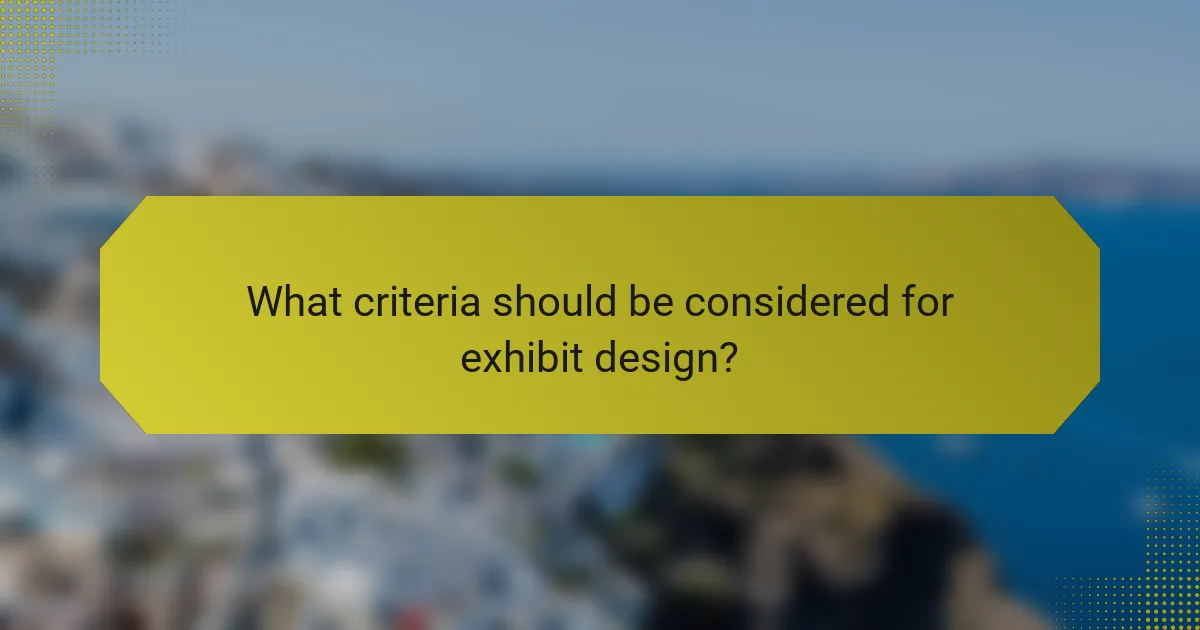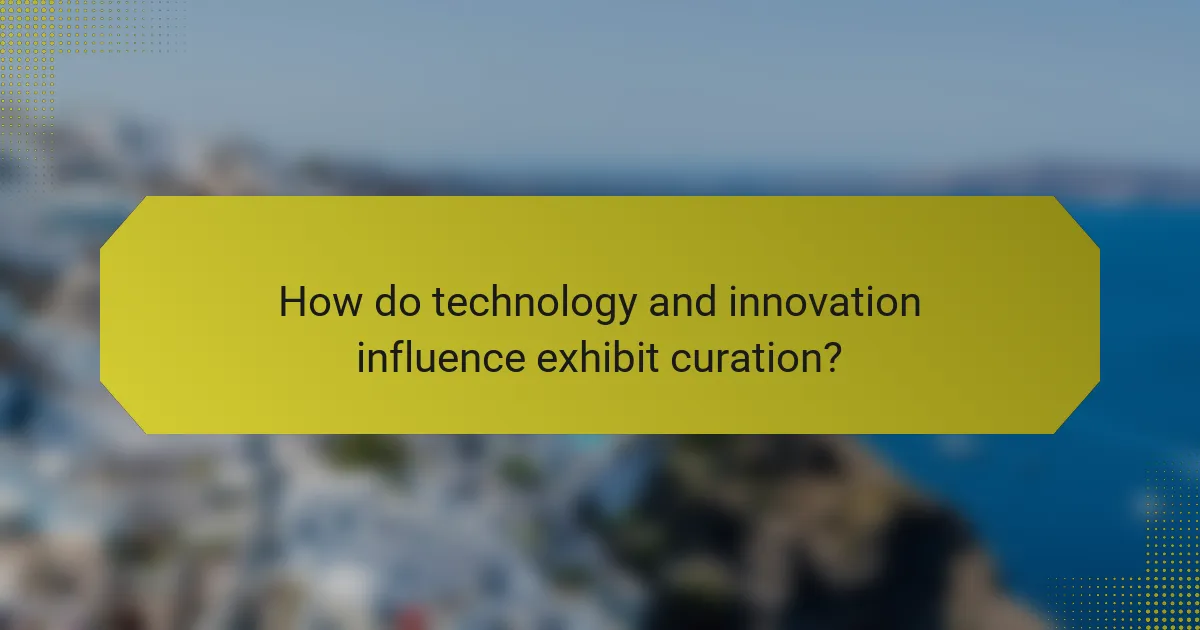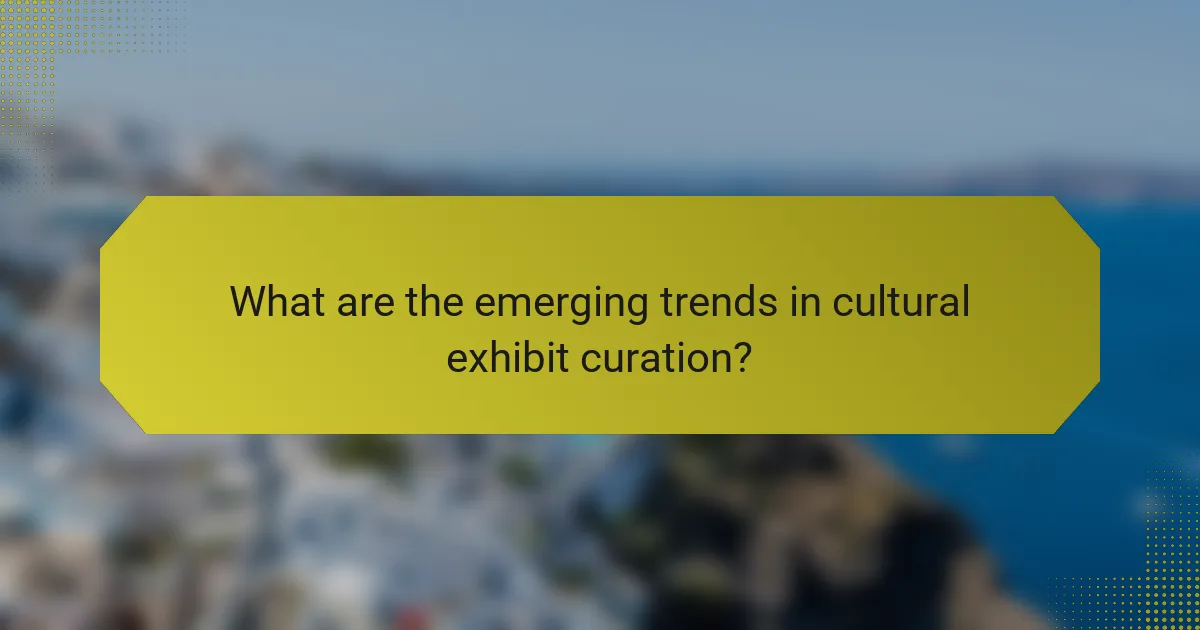Cultural exhibit curation techniques play a vital role in creating immersive experiences that foster a deeper understanding and appreciation of diverse cultures. By integrating storytelling, sensory elements, and community engagement, these exhibits not only captivate visitors but also promote educational encounters. Successful designs and notable case studies demonstrate how innovative approaches can enhance the visitor experience while preserving essential cultural narratives.

What are effective cultural exhibit curation techniques?
Effective cultural exhibit curation techniques focus on engaging visitors through immersive experiences that enhance understanding and appreciation of the displayed culture. These techniques often incorporate storytelling, sensory elements, and community involvement to create memorable and educational encounters.
Interactive storytelling
Interactive storytelling involves creating narratives that allow visitors to engage actively with the exhibit. This can be achieved through multimedia presentations, guided tours, or digital applications that let users explore different storylines based on their interests.
For instance, an exhibit on ancient civilizations might include touchscreens where visitors can choose to learn about specific artifacts or historical figures, tailoring their experience to their preferences. This approach not only increases engagement but also helps visitors retain information more effectively.
Multi-sensory experiences
Multi-sensory experiences enhance cultural exhibits by incorporating various senses beyond just sight. This can include soundscapes, tactile displays, and even scents that evoke the culture being represented. For example, an exhibit on traditional cooking might feature the aromas of spices or the sounds of cooking techniques.
When designing these experiences, consider the balance between sensory overload and engagement. Aim for a cohesive atmosphere that complements the exhibit’s theme without distracting from the main content. Simple elements like background music or textured surfaces can significantly enrich the visitor experience.
Community engagement
Community engagement is crucial for creating culturally relevant exhibits that resonate with local audiences. Involving community members in the curation process can provide valuable insights and foster a sense of ownership over the exhibit.
Strategies for community engagement include hosting workshops, soliciting feedback during the planning stages, or featuring local artists and historians. This not only enriches the exhibit’s content but also encourages local visitors to connect with the displayed culture on a deeper level, enhancing attendance and support.

How do successful museum exhibits enhance visitor experience?
Successful museum exhibits enhance visitor experience by creating engaging, memorable interactions that encourage exploration and learning. These exhibits often incorporate innovative design elements and personalized experiences to captivate diverse audiences.
Immersive environments
Immersive environments transport visitors into a different time or place, making the exhibit more engaging. Techniques such as multimedia displays, interactive installations, and themed spaces can create a sense of presence that enhances emotional connections to the content.
For example, a historical exhibit might use soundscapes, lighting, and props to recreate a specific era, allowing visitors to feel as if they are part of that time. This approach can significantly increase visitor retention and satisfaction, as people are more likely to remember experiences that engage multiple senses.
Personalized tours
Personalized tours cater to individual interests and learning styles, enhancing the overall visitor experience. By offering tailored content, museums can engage visitors more deeply, making them feel valued and understood.
Options such as guided tours with knowledgeable staff, mobile apps that allow for self-directed exploration, or even audio guides that adapt to user preferences can significantly improve satisfaction. Museums should consider incorporating visitor feedback to continually refine these personalized experiences, ensuring they meet diverse needs and expectations.

What are notable case studies in cultural exhibit curation?
Notable case studies in cultural exhibit curation highlight innovative approaches and successful designs that engage audiences while preserving cultural narratives. These examples showcase how thoughtful curation can enhance visitor experience and education.
Smithsonian National Museum of African American History
The Smithsonian National Museum of African American History and Culture employs a narrative-driven approach to exhibit curation, focusing on storytelling to connect visitors with African American history. The museum’s layout is designed to guide guests through a chronological journey, from the early African heritage to contemporary issues.
Key elements include immersive environments, personal artifacts, and multimedia presentations that evoke emotional responses. Curators emphasize community involvement, gathering stories and artifacts from individuals, which fosters a sense of ownership and authenticity in the exhibits.
British Museum’s Ancient Egypt exhibit
The British Museum’s Ancient Egypt exhibit is renowned for its extensive collection and educational focus. Curators utilize a thematic approach, grouping artifacts by cultural significance, such as daily life, religion, and burial practices, which helps visitors understand the complexities of ancient Egyptian society.
Interactive displays and guided tours enhance engagement, allowing visitors to explore artifacts like mummies and hieroglyphics in context. The museum also adheres to international standards for artifact preservation, ensuring that items are displayed safely while being accessible to the public.

What criteria should be considered for exhibit design?
Exhibit design should focus on audience engagement, effective space utilization, and the overall narrative of the exhibit. These criteria help ensure that the exhibit is not only visually appealing but also informative and accessible to diverse visitors.
Audience demographics
Understanding audience demographics is crucial for tailoring an exhibit’s content and design. Factors such as age, cultural background, and educational level can influence how visitors interact with the exhibit. For instance, family-friendly exhibits might include interactive elements, while those aimed at adults may focus on detailed information and sophisticated design.
To effectively cater to different demographics, consider conducting surveys or utilizing visitor data to inform your design choices. This can help in creating targeted experiences that resonate with specific groups, enhancing engagement and satisfaction.
Space utilization
Effective space utilization maximizes visitor flow and enhances the overall experience. Consider the layout, ensuring that pathways are clear and that exhibits are spaced to allow for comfortable viewing. A well-planned flow can prevent overcrowding and encourage exploration.
When designing the exhibit, evaluate the physical dimensions and constraints of the space. Use flexible display options, such as modular setups, to adapt to varying space requirements. Additionally, ensure that the design accommodates accessibility standards to welcome all visitors, including those with disabilities.

How do technology and innovation influence exhibit curation?
Technology and innovation significantly enhance exhibit curation by providing immersive experiences and engaging storytelling methods. These advancements allow curators to create dynamic environments that attract diverse audiences and facilitate deeper understanding of the exhibits.
Augmented reality applications
Augmented reality (AR) applications overlay digital information onto the physical world, enriching the visitor experience. For instance, museums can use AR to provide interactive guides that display additional content when viewers point their devices at specific artifacts.
When implementing AR, consider the technology’s accessibility and user-friendliness. Ensure that the application is compatible with a wide range of devices and provides clear instructions for use. A common pitfall is overwhelming visitors with too much information; focus on key highlights to maintain engagement.
Digital storytelling platforms
Digital storytelling platforms allow curators to weave narratives that connect artifacts and themes in innovative ways. These platforms can include multimedia elements such as videos, audio guides, and interactive timelines, which help to contextualize exhibits and enhance visitor understanding.
When selecting a digital storytelling platform, prioritize ease of use and integration with existing systems. Consider platforms that allow for audience interaction, such as feedback options or social media sharing, to foster community engagement. Avoid overly complex narratives that may confuse visitors; clarity and coherence are essential for effective storytelling.

What are the emerging trends in cultural exhibit curation?
Emerging trends in cultural exhibit curation focus on sustainability, technology integration, and audience engagement. These trends reflect a shift towards more responsible practices and innovative approaches that enhance visitor experiences while minimizing environmental impact.
Sustainability practices
Sustainability practices in cultural exhibit curation involve using eco-friendly materials, reducing energy consumption, and promoting conservation efforts. Museums are increasingly opting for recycled or sustainably sourced materials in their displays and installations.
Additionally, curators are implementing energy-efficient lighting and climate control systems to decrease the carbon footprint of exhibits. For example, using LED lighting can reduce energy use by up to 75% compared to traditional bulbs.
To further enhance sustainability, curators should consider partnerships with local organizations focused on environmental education and conservation, creating programs that engage the community in sustainability efforts.
Virtual exhibitions
Virtual exhibitions have gained popularity as a way to reach broader audiences and provide accessible experiences. These digital platforms allow museums to showcase their collections online, enabling visitors from anywhere in the world to explore exhibits without physical barriers.
When designing virtual exhibitions, curators should focus on interactive elements, such as 3D models, video tours, and augmented reality features, to enhance engagement. For instance, a virtual tour of a historical site can include clickable hotspots for additional information.
It’s essential to ensure that virtual exhibitions are user-friendly and compatible with various devices. Curators should test their platforms across different browsers and devices to provide a seamless experience for all users.

How can cultural institutions measure exhibit success?
Cultural institutions can measure exhibit success through visitor engagement metrics, feedback surveys, and educational outcomes. These indicators help assess how well an exhibit meets its goals and resonates with the audience.
Visitor Engagement Metrics
Visitor engagement metrics include attendance numbers, time spent in the exhibit, and interaction rates with displays. Tracking these metrics can reveal patterns in visitor behavior and highlight which aspects of the exhibit are most appealing.
For instance, if an exhibit attracts thousands of visitors but they only spend a few minutes inside, it may indicate a need for more engaging content or layout adjustments. Institutions can use tools like visitor tracking technology to gather this data effectively.
Feedback Surveys
Feedback surveys are a direct way to gather visitor opinions and experiences. Institutions can distribute surveys both online and on-site to capture immediate reactions and suggestions for improvement.
Surveys should focus on specific aspects, such as the clarity of information presented, the emotional impact of the exhibit, and overall satisfaction. Analyzing this feedback can guide future exhibit designs and enhance visitor experiences.
Educational Outcomes
Measuring educational outcomes involves assessing how well an exhibit meets its educational objectives. This can be done through pre- and post-visit assessments, interviews, or interactive activities that gauge learning retention.
For example, if an exhibit aims to teach visitors about a specific cultural practice, institutions can evaluate whether visitors can recall key information after their visit. This data can inform whether the exhibit successfully conveyed its intended messages and educational goals.


